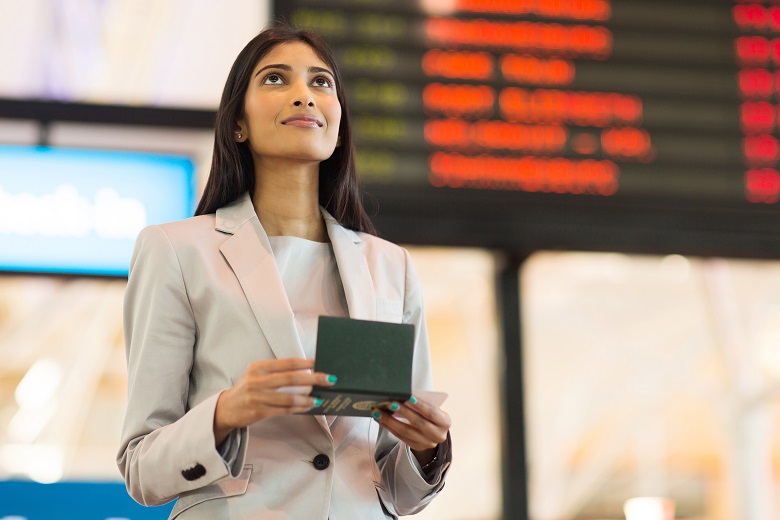
Since 2008, Indian passport holders are eligible for e-visa of Vietnam (30 days, single entry). You can apply online at the official website of the government of Vietnam https://evisa.immigration.gov.vn or if you are not confident to apply at the official website, you can apply online through our website with 100% money back policy.
In case you want to stay for more than 30 days or want to get multiple entry visa, it is best that you avail the Vietnam Visa on arrival. The Vietnam visa on arrival processis pretty simple. This has been considered to be the first and a preferred option for all of the people who require Vietnam visa for tourism purposes. Since 2005, Indians can apply for visa on arrival Vietnam through a travel agency in Vietnam, no need to queue at the embassy of Vietnam anymore.
Now, the Indian citizens, like the citizens of any other place, can apply for a visa through the same procedure. Every applicant needs to enter their detailed personal information on the form. When talking price, the visa on arrival is best chosen by the people. It is very cheap when compared it to embassies’ charges and helps save money. These prices can turn out to be even better if a group of people applies together. The documentation and verification procedure requires time but when you are availing visa on arrival, you can be pretty sure that the procedure is done at full speed. When applying for visa on arrival, you have the ability to apply from any part of the world, be it UAE, India, Singapore or Malaysia. You can even apply for such visa online without having appointment beforehand.
Vietnam visa on arrival means that the visa is handed down to the person at the arrival section of the airport, however, the travelers must hold a visa approval letter from the Immigration Department of Vietnam then able to pick up their visa on arrival.
Just find a reliable website offer best price then submitting the application for the visa approval letter, then the website owner will arrange the approval letter and send it to your email. This must be done before flying off to Vietnam. There is not even a single airline which will allow you to board the flight if you do not have the approval letter. It is required to be shown at the check-in counter. The airlines will require showing the approval letter. Thus, it is highly essential that the approval is taken before departure.
If you have a valid passport, 2 photographs and the required fees, we can help you get Vietnam Visa on Arrival letter at Vietnam immigration department, print it, and get it stamped.
There are two different parts of procedures:
1. Vietnam visa process for tourist visa application
For the tourist visa (category DL), please remember to choose purpose of your visit is for tourist when you filling out the visa application form online. Once the application is made, the next step is to proceed with the payment.
The most commonly found problem that the Indian citizens make while filling the form is entering the entry / exit date, their date of birth section. There is a particular format to enter the date in Vietnam – dd/mm/yyyy. Consider an example, you were born on 12th July 1978, you will have to enter 12/07/1978 or 12/Jul/1978.
2. Vietnam visa process for business visa application.
Applicants seeking a business visa (category DN), please remember to choose purpose of your visit is for business when you filling out the visa application form online. It is confirmed that there is no document required except the copy of your passport.
After this processing is completed, normally 2 working days, the website owner will send you a visa approval letter with instructions to your email address, please to check your email including spam box or junk box to make sure you got it before going to Vietnam.
On the arrival airport of Vietnam, you will see the landing visa counter also called visa on arrival desk, you will need to submit your original passport, printed copy of approval and completed the entry and exit from with a passport sized photo then wait to be called to pay for stamping fee and get back your passport with the visa inside.
To make it easy and hassle free for you, we can help you with every aspect of obtaining a Vietnam Visa on Arrival. Contact us for a seamless Visa experience.
The flavors and freshness of Vietnamese cuisine are irresistible. You’ll find a vendor selling something that looks and smells delicious on every corner. It’s only natural that you’d want to sample it all, but unfortunately there’s so many amazing foods in Vietnam that this may not be possible. Our recommendation is to try as much as possible, however below you’ll find eight dishes that you simply cannot leave Vietnam without trying:
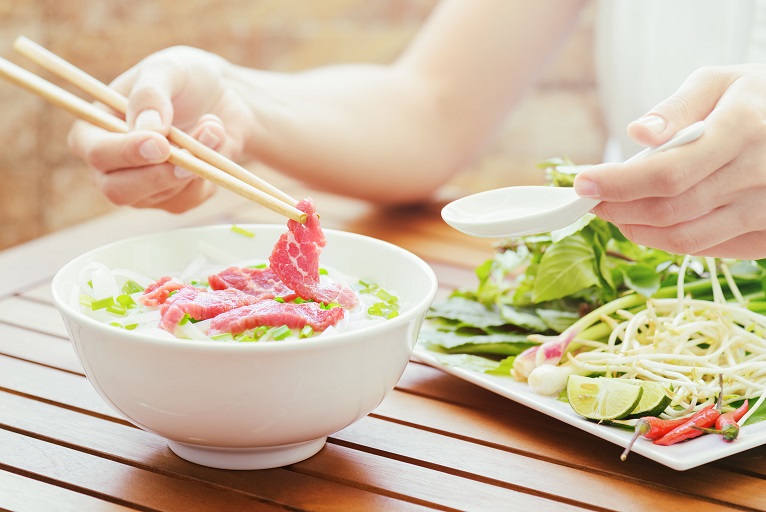
The most well-known Vietnamese food is probably Pho, and for good reason. This savory, satisfying soup is a staple in Vietnamese cuisine, and you’ll primarily see people eating it for breakfast. However, feel free to order a bowl whenever you want; there’s never a bad time for Pho. This beloved soup starts as rice noodles bathed in a tasty broth, typically followed by some form of beef (if you’re a vegetarian, skip the meat). The soup is then topped with bean sprouts and a spattering of greens like basil and green onion. Pho is served with salty, spicy, fermented fish sauce and a lime wedge. This is a popular dish that’s been adapted in restaurants worldwide, however Pho is an absolute must-try in its country of origin.
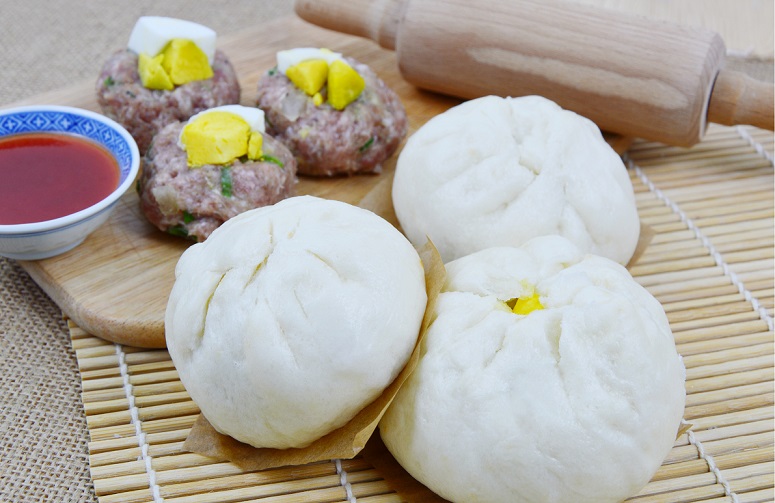
This soft, doughy, ball of steamed white bread is a common breakfast food or mid-day snack often sold from mobile street vendors. The bun is typically filled with pork and half a hard-boiled egg or quail egg, however there are many other varieties including BBQ pork, chicken, or vegetarian-friendly options. There are even sweet buns, stuffed with a custard-y filling, or the purple-colored buns which usually contain sweet potato.
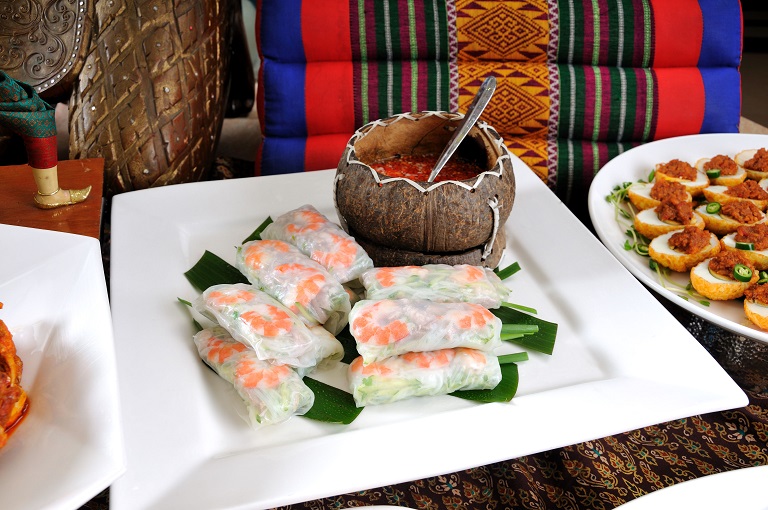
These are the freshest spring rolls you’ll ever taste. The transparent rice paper outside wraps up greens, coriander, pork, and prawn in a perfect bite-sized package. Gỏi Cuốn is served with a savory dipping sauce topped with crushed peanuts and spicy chili peppers. Usually a little mint or basil accompanies the dish on the side. These are a great choice if you’re looking for a healthy appetizer. If you’re not too bothered about the calories, you can also order them deep-fried (called Nem Rán or Chả giò).
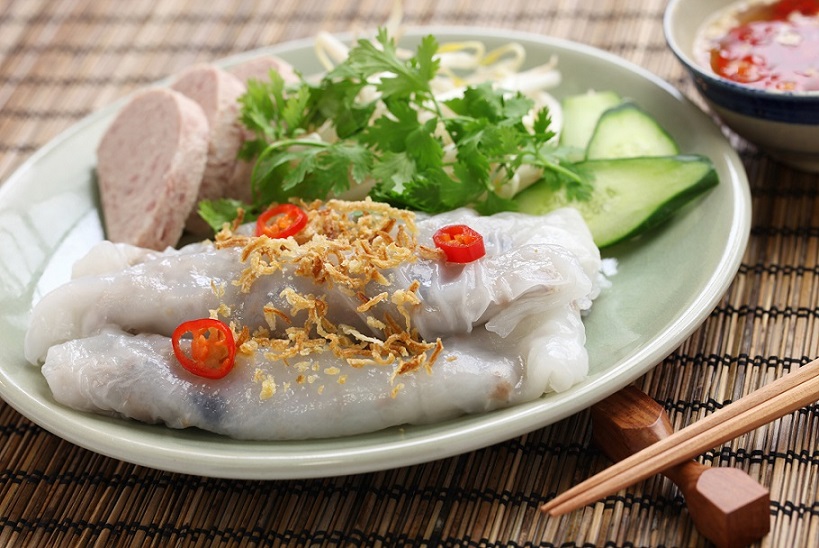
Banh Cuon translates to ‘’rolled cake’’, which is a pretty accurate description of what it is. This scaled-up version of the spring roll packs a few more ingredients than its slimmer counterpart. The main components of the rolled cake is a ground meat (pork, chicken or shrimp) and various vegetables like mushrooms, bean sprouts, onion, and cucumber all wrapped up in a steamed translucent rice paper. It’s a perfect grab-and-go snack favored among travelers who need to stay fueled and energized for all that sightseeing.
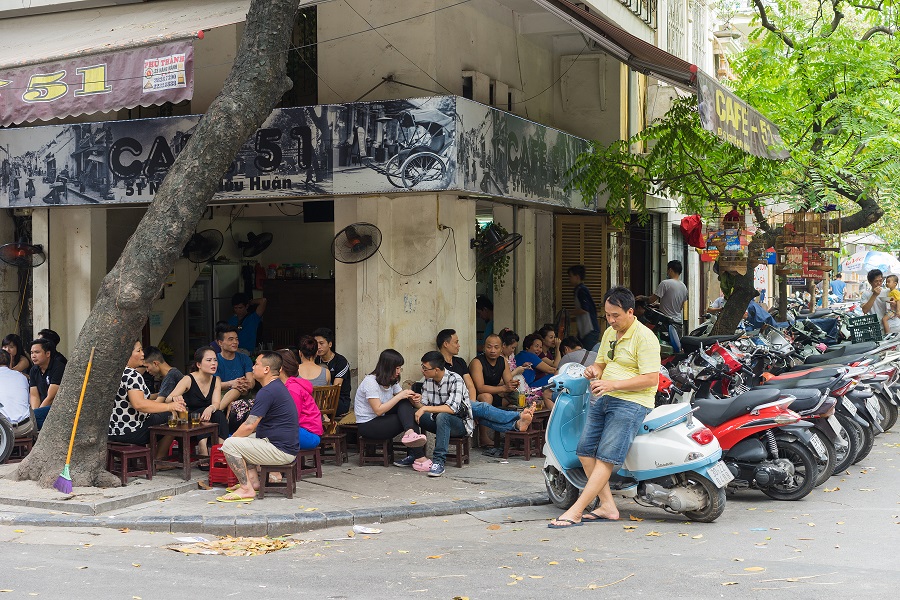
If you’re looking to jump-start your day or need a little kick in the afternoon, look no further than Vietnamese coffee. Once you order a cà phê, you’ll get to watch your drink brewed right in front of you. You’ll be served a petite glass coffee cup with a metal French drip plunked right on top of the glass. The dark roast slowly drips through the filter and into your cup. It’s common for Vietnamese coffee to be served with condensed sweet milk on the side or already portioned out in the coffee cup. The combination of the milk’s sticky sweetness and the coffee’s flavorful bitterness is unmatched by any other cup o’ Joe in the world.
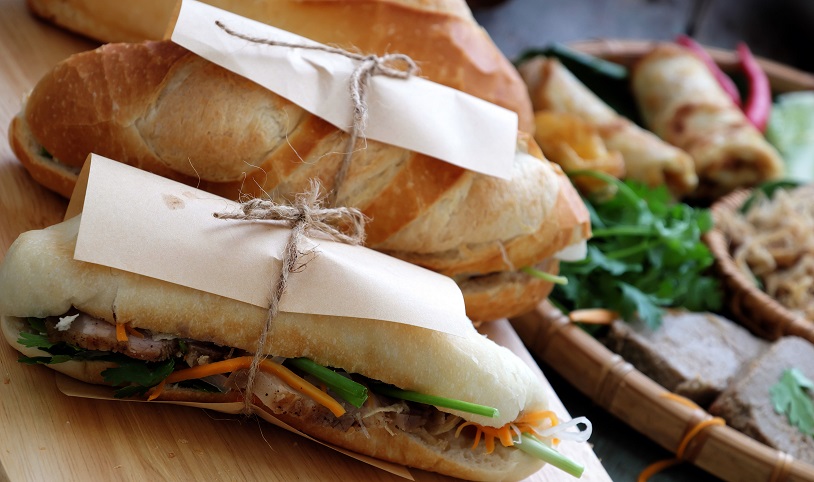
Best described as a French-Vietnamese fusion sandwich, this is one of Vietnam’s tastiest and cheapest quick meals. A French-style baguette is toasted with butter, spread with a salty pate, stuffed with fresh and pickled vegetables, and includes your choice of meat or protein filling (pork, fish, chicken, or egg/omelet). One of these will run you roughly $1, which means you can totally afford to come back for seconds.
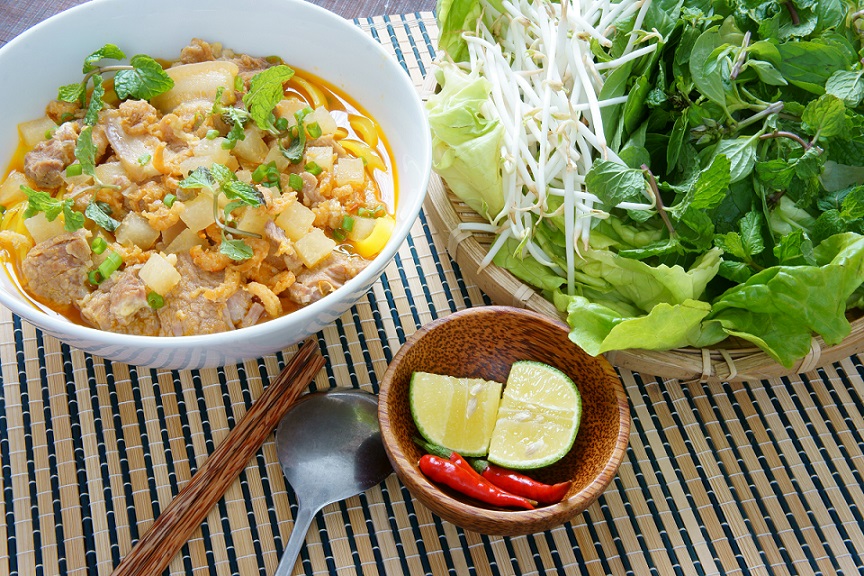
If a big bowl of carbs is what you’re craving then Mi Quang fits the bill. Rice noodles seasoned with turmeric and bone broth are topped with pork, quail eggs, and shrimp. It’s served with a plate of greens (like many dishes in Vietnam) with basil, mint, and lettuce. Cheap and filling - just what every budget backpacker needs.
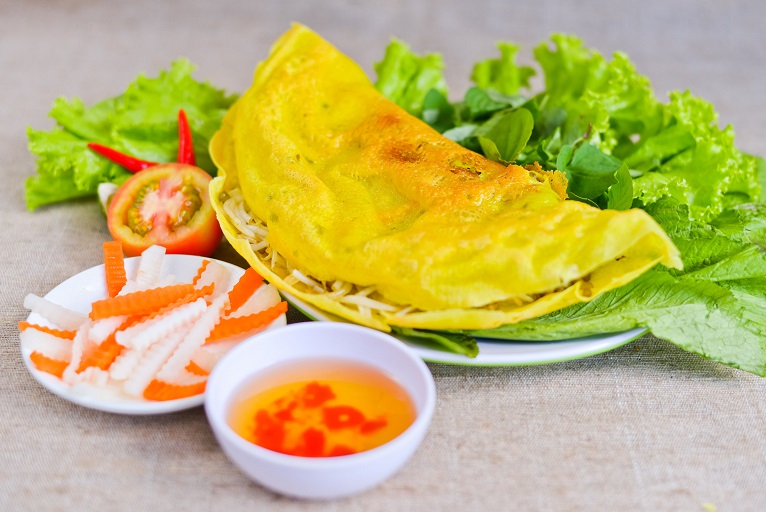
It’s hard to resist the sound and smell of pancake batter frying in a pan and that’s exactly what makes Bánh Xèoone of Vietnam’s best foods. Literally translating to “sizzling cake”,Bánh Xèo is a cross between a sweet crepe and a savory omelet. The batter is made from rice flour, coconut milk, and turmeric. The mixture is fried in a skillet, then filled with bean sprouts, green onion, and thinly sliced pork or shrimp. This dish is typically served with a bunch of greens which you can use to wrap up torn off bits of the Bánh Xèo. Stuff a few mint or basil leaves in the wrap, then dunk it in the salty, fermented peanut sauce. Now you’re eating like a local!
************
If there’s one rule of thumb for traveling in Vietnam, it’s to come hungry and eat often. The only mistake you can make is leaving the country without trying one of our top 8 picks!
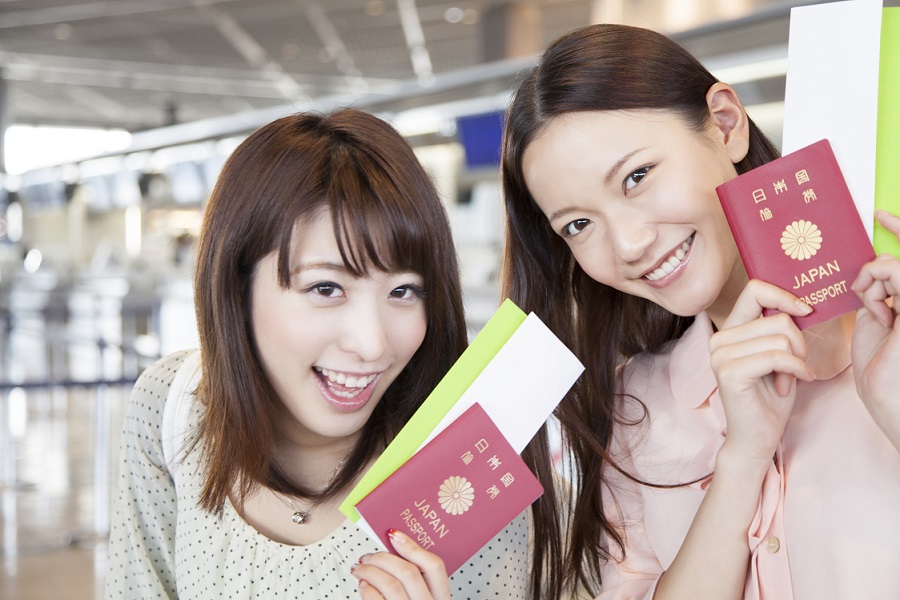
Beginning your Vietnam adventure in a Hanoi is the best decision. It’s possible to spend weeks in the capital city exploring the side alleys and offshoots, finding all the hidden local spots, and befriending the other expats that have made Hanoi into their temporary home.
Of course, there are many things Hanoi is famous for that should also be experienced by someone visiting the city for the first time. What makes Hanoi such an exceptional starting point for traveling the country is its proximity to many other must-see attractions.
Below, we’ll guide you through some of the coolest, craziest, can’t-miss attractions in and around Hanoi!
Arriving in Hanoi can be overwhelming. Finding a cool hostel or guest house that hosts lots of activities makes discovering Hanoi a whole lot easier. Search for accommodation in the Hoàn Kiếm district for a high concentration of popular hostels with lively atmosphere.
*Many of these backpacker-friendly guest houses hook their guests up with access to a free city walking tour. Taking one is strongly recommended! This is the best way to discover a few hidden spots, learn a little something about the country from your local guide, and get your bearings in Hanoi.
After your city tour, be sure to check these attractions off your list:
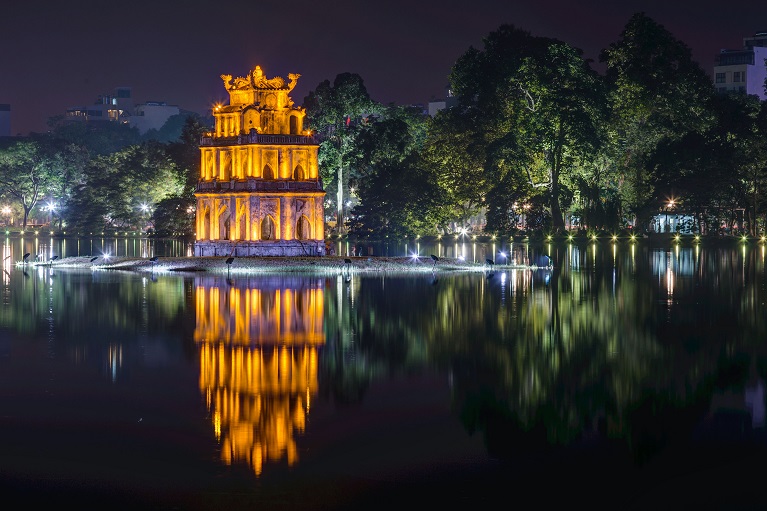
This is like Hanoi’s equivalent to New York City’s Central Park. Popular with both locals and tourists during all hours of the day and evening, this oasis serves as an escape from the otherwise frantic pace of the city. TheNgoc Son Temple sits on a small island in the middle of the lake, connected to the land by a brightly-painted bridge. This is a great place to come to relax and people watch.
The best place to experience this one-of-a-kind Vietnamese art form is at Thang Long Water Puppet Theatre. Located on the iconic Hoàn Kiếm Lake, this theater has the best reputation in town. The stage is water and the puppets glide across the surface, telling ancient legends, folklore and stories of the rice harvest. A (loud) orchestra accompanies the puppets as they put on their show.
Yes, you read that right. In Hanoi, it’s possible to go to a snake restaurant. Here you’ll be introduced to your snake and watch it killed in front of you. The wildest part is you’ll also have the opportunity to eat the heart right out of the snake after it’s been cut! Afterwards, a multiple course meal is prepared entirely from the snake - including snake ribs. What’s on the drink menu? Snake blood, bile, or a mixture of the two. Of course, this activity is not for everyone, but it’s certainly a crazy way to spend an evening in the city.
This area is fascinating and fun. Wander around and admire the colonial architecture, observe the organized chaos of the traffic, and browse the numerous fruit and vegetable street markets and small shops. This is also the best place to enjoy cheap eats, like the famous Vietnamese Pho or Bánh Bao, a soft white bun with savory filling.
Drink a $0.25 beer
While you wander, you’ll likely stumble across several makeshift corner bars. These bars pop up on corners all around Hanoi and consist mainly of a keg of Bia Hoi and plastic tables and chairs. Take a load off with the locals and grab a plastic cup of the cheapest beer you’ll ever pay for.
While Hanoi is a super fun and exciting city, there’s also so much else to do nearby. Check out our picks for the two trips that are an absolute must:
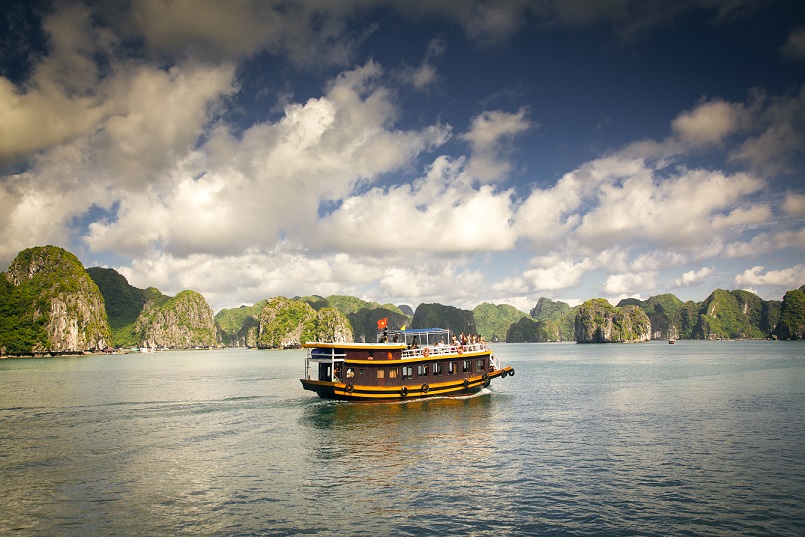
This enchanting World Heritage seascape is definitely one of Vietnam’s most breathtaking sights. Halong Bay’s emerald-green water dotted with 1,600 limestone karsts and topped with vivid greenery is like a page straight out of a fairy tale. It’s a truly unbelievable sight - rain, shine, or fog - Halong Bay must be explored.
Halong Bay is about 3.5 hours from Hanoi, however it is possible to squeeze the whole experience into a day trip. The best way to see Halong Bay is, of course, by boat. There are plenty of options for boat tours, ranging from budget to super-luxury. Some boats may offer overnight packages. Mid-range to high-end cruises typically offer sea kayaking as part of the deal.
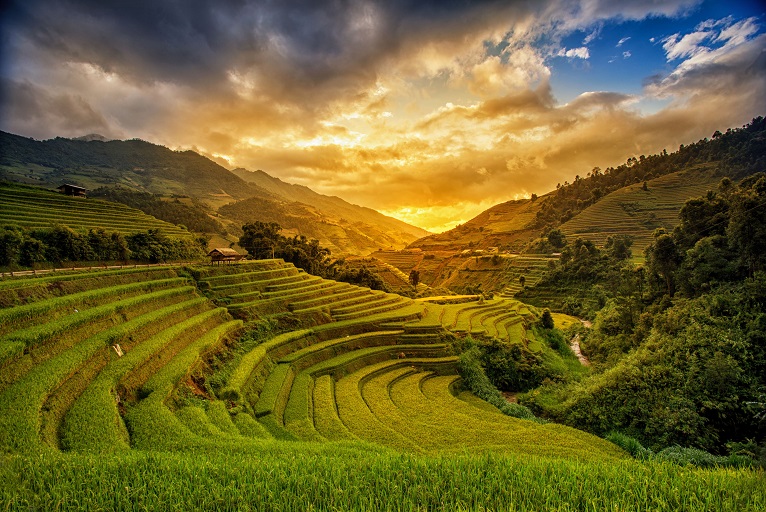
Way up in the northern corner of Vietnam, over 300 kilometers from Hanoi, travelers find a welcome relief from the frenzied city’s heat and grime. Sa Pa, nestled deep in the Hoang Lien Son mountain range, is the trekking mecca of Vietnam. Sa Pa’s famous landscape of bright-green rice paddies rising and falling between the mountains and valleys carry on as far as the eye can see. The lush vegetation of the region’s countryside emanates the kind of peaceful serenity that accompanies the simple lives still led among the village tribes that call Sa Pa home. Trekking through the area and spending the night in a homestay is the best way to discover this captivating area.
Most people take the night train from Hanoi to Lao Cai Railway Station. The journey is about 8 hours and most have sleep beds in each car. You can also take an overnight bus or express bus (day time) from Hanoi.
From the hectic city life of Hanoi, to the mysterious waters of Halong Bay, to the tranquility of Sa Pa; no trip to Vietnam could be considered complete without experiencing them all.
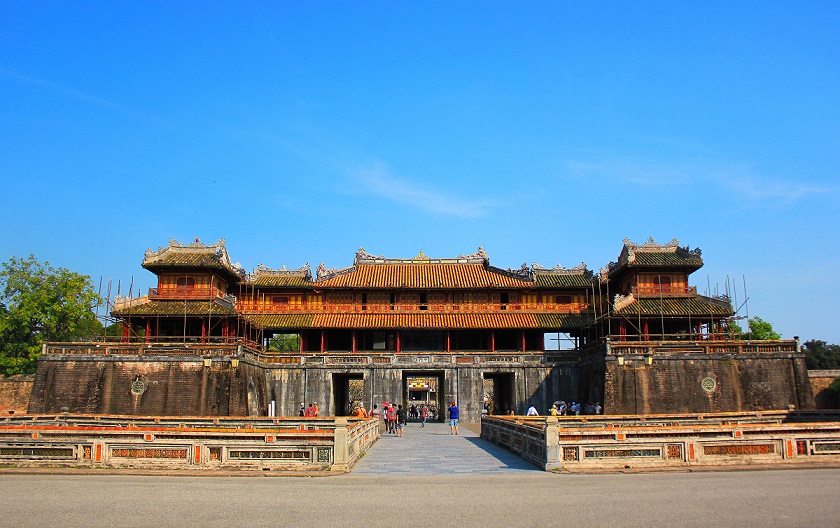
A Vietnam travel plan usually means urban visits to Ho Chi Minh and Hanoi, or the outlying beautiful locations of Halong Bay and Hoi An. However, tourists cannot afford to miss out on the most historical place of Vietnam, Hue, which resonates of stories of the medieval pre-Communist past.
Hue was established as the capital of the Vietnam in 1802 as the political, cultural and religious seat of the Nguyen dynasty until 1945. Today Hue is a combination of the Hue Citadel, the Imperial City, the Imperial Residence, the Forbidden Purple City and the Inner City, making this feudal city a place of great historical relevance. The purple-tinged stonework of the Hall of Supreme Harmony has perhaps given Hue the epithet of the “Forbidden Purple City”.
Outside Hue there are other historical monuments and ritual sites - the Van Mieu (Temple of Literature), the Dan Nam Giao (Esplanade of Sacrifice to the Heaven and Earth), the Ho Quyen (Royal Area), the Den Voi Re (Temple of the Roaring Elephant), and the Chua Thien Mu (Celestial Lady Pagoda).
Anytime during the dry months is a good time to visit Hue. However, if you can time your visit to coincide with the Hue Festival usually held in April, you can witness Vietnamese tradition and heritage in its true spirit.Generally, February to April is a good time, to avoid the hot, humid weather.
Hue is the best city to experience Vietnamese history, culture and tradition.
The Hue Citadel are the structure of four citadels that make the Capital City - Hoang Thanh /Imperial City that houses the royal palaces and shrines, Tu Cam Thanh / the Forbidden Purple City that was the former royal residence, Dai Noi / the Inner city and Tran Binh Dai. As it extends over a large area, you can take a taxi or hire a bicycle to explore the site.
The historical Thai Hoa Palace was the Royal Meeting and Ceremonial Hall, and is a popular tourist attraction today.
The Hue Antiques Royal Museum, formerly Khai Dinh Museum, houses an extensive collection of royal treasures. It is a must-visit, for the amazing oriental artefacts of the royal period.The museum showcases Vietnam’s handicraft, paintings, literary works, made by Hue artisans during the medieval period. These remarkable works use a wide range of materials such as gold, silver, jade, ivory, glass, stone, wood, leather, fabrics, paper, bamboo, rattan and terra cotta. The museum is a true combination of history, royalty and the region’s rich tradition of arts and crafts.
There are seven Royal Tombs near the city of Hue. Of these the tombs of Minh Mang, Tu Duc, and Khai Dinh are more popular with the tourists. These tombs are elaborate structures, and fine example of architectural fusion.
Thien Mu Pagoda is a towering 7-tiered temple perched on a hill overlooking the Perfume River. Also known as the Pagoda of the Celestial Lady, the temple dates back to the early 17th century. The temple has inspired many folk rhymes and is symbolic to Hue. It is a must-see for its architectural splendour and magnificence.
The The Mieu is a beautiful ancestral temple dedicated to the former rulers of the city, constructed by King Minh Mang in 1823. Highlights are the nine urns in front of the temple, dedicated to the royal ancestors.
The Thanh Toan Bridge is another dated historical construction visited for its architectural beauty. Visit at night when it is lit up and looks magnificent.
The Bach Ma National Park is a national park, rich in biodiversity that you may like to visit.
Royal Banquet dinners are a recent tourist attraction which allows you a retro look into the medieval culture of Hue dynasty. Dress up as Vietnamese royalty and dine on traditional dishes that have a Royal influence while you listen to traditional music.
A bike ride through the countryside lets you explore the tombs in the outlying areas and the picturesque landscape of the river, while you enjoy Hue cuisines and watch royal enactments.
A dragon boat cruise down the Perfume River is a fine way to see the region and traditional settlements. The river gets its name from the various orchards flanking the river banks that lend a flowery perfume to the river.
Visit the ancient Dong Ba Market and pick up some of the fresh Southeast Asian fruits you will not find elsewhere - custard apple, gac, or durian. Buy a Vietnamese conical hat and try to get your tour operator take you to those villages where conical hats and incense sticks are handmade.
Visit the Lang Co Beach to relax and cool off. However, get yourself a lifeguard, as the waters can get choppy.
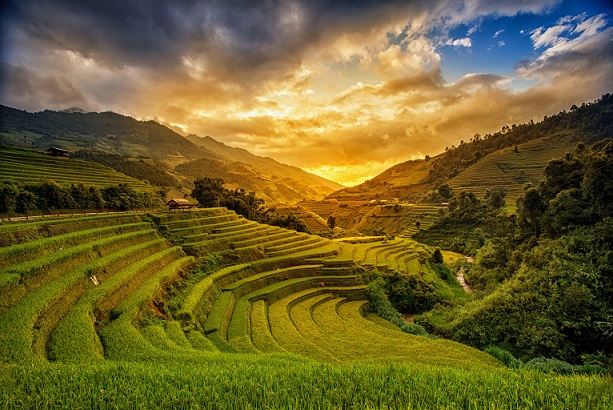
Located in northern Vietnam in the Lao Cai Province, Sapa’s iconic rice paddies and towering mountain ranges attract a diverse range of visitors throughout the year. The quiet mountain town is filled with diverse ethnic minority people and villages in the surrounding area.
A truly unique destination, 380km northwest of Hanoi, the Hoang Lien Son mountain range is vast and spreads throughout the town. A very popular place for trekking and hiking, Sapa is home to a rich culture, fascinating people and beautiful scenery. Be surrounded by natural beauty and indulge in Vietnamese life and culture.
As a mountain town with no airport, Sapa is accessible by road or train only. Catch the overnight train from Hanoi which takes around 8-9 hours and stops in Lao Cai. You will then need to travel another hour from Lao Cai station to reach Sapa. The other option is to travel by bus and is a faster alternative. Buses depart daily from Hanoi and take 6-7 hours.
Sapa is an extremely charming town and once you step out into the lush green fields and rice paddies, you’ll never want to leave. To make the most out of your time in northern Vietnam, here are eight great things to see and do in Sapa.
The highest mountain in Indochina, the trek to the peak of Fansipan mountain is not to be taken lightly. There are serval tour options that can be found in various hostels and hotels, offering one or two-day treks. You do need to be physically fit for the hike and have a high level of endurance. If this isn’t for you but you would still love to see the view from the top, there’s always the cable car. You can buy a return journey from the bottom and soak up the breathtaking views on the 20-minute cable car ride.
Thac Bac Waterfall also known as Silver Falls can be found less than 15km from the centre of Sapa. The waterfalls can be easily reached by car or motorbike. A serene and calming area, you’ll find incredible views along the journey.
There are several restaurants on the Sapa dining scene suitable for a wide range of budgets and requirements. Head for Cau May Steet, the main area for restaurants and cafes. The Moment Romantic Restaurant has a superb Vietnamese menu with a number of vegetarian options. Other popular spots for an evening meal include Rose Garden and Gerbera Restaurant.
A homestay in Sapa is a fantastic experience and the chance to do something completely different. Fully learn and discover customs and traditions some ethnic minorities live by in Sapa. A homestay usually involves a trek to one of the ethnic minority villages and then an overnight stay in someone’s house. It might not be for everyone but if you’re willing to leave the comfort of your hotel for one night to experience true village life, then this one’s for you.
The old H’Mong hill tribe village is very popular for its unique culture. One of several ethnic minorities in Sapa, Cat Cat Village is beautifully set amongst a dramatic backdrop of mountains and sits at the base of Fansipan mountain. If you’re not in the mood to trek to the village, you could always hire a motorbike for the day and save some time.
The main market in Sapa is open every day of the week but the most popular day to head there is Saturday. Several members of the hill tribe villages around the town, including the Red Dao and Hmong, visit the market to sell handmade crafts and clothing. Grab some food from one of the many stalls and start exploring the market.
The picturesque valley is a must-visit while in Sapa. The stretching and curving Hoa Stream travels through several of the minority villages in the town. A completely picture-perfect moment, be sure to take a look at the iconic terraced rice fields in the valley.
The sapa food court can be found right next to the central square, in front of the church. There’s plenty of options that are sure to satisfy even the pickiest eaters. Head to the food court in the evening and try some Pau Play Day Cake.
The captivating mountain town is a truly magical destination. The fresh air, incredible scenery and diverse culture offer visitors a unique experience. Whether you love hiking or prefer to just relax and take in the views, Sapa is versatile and suitable for all ages.
If you’re looking to fully explore the north of Vietnam, it’s best to fly into Hanoi airport. Then you’ll be based centrally and can either travel to Sapa or maybe head off to Cat Ba Island at the southeastern edge of Ha Long Bay, the choice is yours.
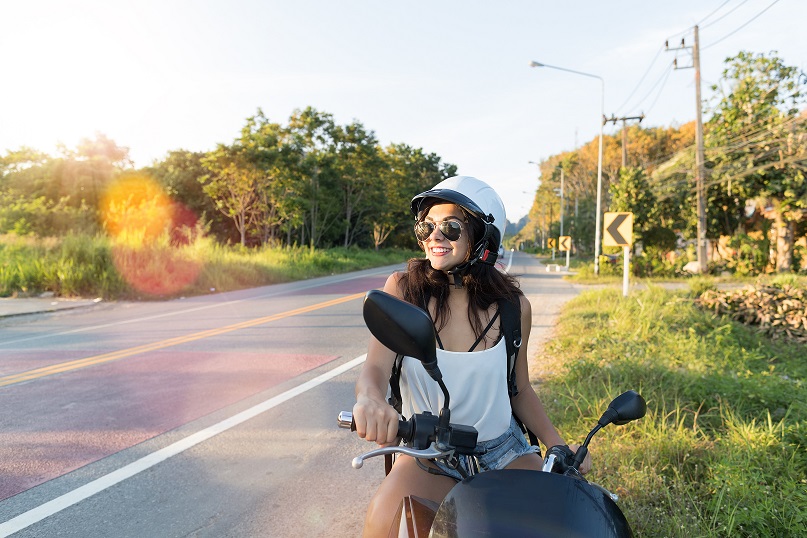
Vietnam is a beautiful travel getaway to rejuvenate your mind and life. However, before taking the trip, there are certain essential things you need to know about the place for proper planning and a smooth experience.
There are a variety of options for means of transport in Vietnam which work on the shared basis. You can travel by hop on- hop off buses which run along the major routes of the key cities of the country. You can also find deluxe sleeper buses and Cylo a.k.a. Rickshaws in Vietnams. There is a faster mode of transport as well, and that is the ‘shared vans’ which run across the cities.
If you want a more smooth and comfortable ride, go for a personal taxi which will take you to all the places you want to go, from tourist spots to the airport. The most famous and reliable taxi services in Vietnam are MAI LINH OR VINASUN TAXIS.
Motorbikes are a popular mode of transport in Vietnam. These motorbikes make for great adventure companions. However, one must always be safe with motorbikes so as to avoid accidents. Make sure you take all precautions and carry appropriate road safety gear with you. A helmet is a must here.
The weather in Vietnam is highly unpredictable. It varies multiple times in a day. The morning might be sunny, but you can expect rains at any time of the day. Thus, be sure to pack an umbrella or raincoat to avoid getting drenched in the rains. The weather also changes across the country, which means it might be snowing in Sapa, but the sun would be blazing in Phu Quoc so prepare your itinerary accordingly.
In cities like Ho Chi Minh and Hanoi, the traffic is really chaotic and crazy. If you are someone who is traveling to an Asian country for the first time, be prepared to be baffled. There are scores of motorbikes on the road accompanied by a lot of honking. Be careful while you cross the streets. Do not panic and maintain a slow and steady pace all throughout so that the riders and drivers know you are crossing the street.
Apart from the picturesque tourist places, one thing that is going to make your trip worth is the Vietnamese food. The food in Vietnam is very delicious with multiple options for vegetarians as well. You should go for some of the famous Vietnamese dishes like the Goi Cuon and Banh mi. There is a reason Vietnam is called a paradise for the foodies.
Accommodations in Vietnam are plenty with the majority of them being cheap and clean. The most popular types of accommodations are hostels and hotels. The hotels here are luxurious with all the amenities, some even have the exquisite rooftop bars. The hostels of Vietnam are equally good. They are way too cheaper and cleaner with all the basic amenities. The staff here is warm and hospitable.
Tourists often go gaga over the connectivity of WIFI in almost every major city of Vietnam. It is everywhere and the reception is simply awesome. So, if you have any bookings to do or any important work to complete, you will find WIFI wherever you go.
How to get Vietnam Visa on arrival? This method works best for business executives or constant travelers who are not present in their home countries at the time of applying for the visa. This makes it hard for them to get the Vietnam visa approval and the visa from the embassy. Thus, they opt for Visa on arrival. Getting Visa on arrival is gaining more and more popularity owing to its effectiveness. Following is the Vietnam Visa process for this type of visa:
There are several companies which provide their services for completing the Vietnam Visa process. You fill out a form online through your company, rest every other aspect of the Vietnam Visa process is taken care of by the company. You finally receive a Visa approval letter through the mail, which you need to carry it to the Airport when you land in Vietnam. This is the smoothest way to get your Vietnam Visa process done in less time.
For any assistance on how to get Vietnam Visa or if you want to get your Vietnam Visa process done in a hassle-free way, you can reach out to us at www.visa-vietnam.org. We are a leading company in helping tourists complete their Vietnam Visa process in the most seamless manner possible.